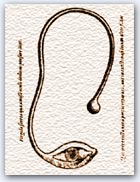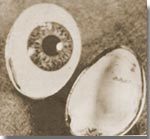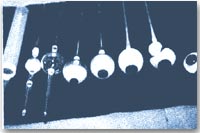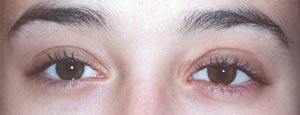| “Love doesn't make the world go 'round. Love is what makes the ride worthwhile.” | |
Our first trip to see the ocularist in LA was just a little traumatic...for me. Oh, you were worried about Oli? No, she was fine. I mean she cried a little bit when her ocularist Mr. Haddad (www.ocularpro.com) first put her new conformers in but, it only took literally about 5 seconds for each eye. At least for her first set.
As her eyes stretched and the conformers got bigger sometimes it was hard to get them past her eye lids. She has only had a couple sets that were really difficult to get in. Once they are in they're not painful. Well, wait, I guess I don't know that they're not painful since she can't tell me. I don't think they are though because Oli doesn't try to claw my eyes out or maim me in some way which is what she does when she is in pain.
The trips to see Mr. Haddad, and later his partner Beverly, were exhausting. We drove 6 hours (one way) to Hollywood, CA from Las Vegas every 3-4 weeks. We were usually gone about 14-16 hours total because of the time it took to snail through traffic in Los Angeles. We never stayed over night because it was just too expensive and usually one of us had to work the next day. We took both children with us every single time. Kekoa was 19 months old when we went the first time and Oli was 2 months. To say that it was a little stressful sometimes would be an understatement. But that is what Oli needed so that is what we did. Thank God for little portable TV's you put in the car. However, if I never hear or see the movie Cars again it will be too soon. Kekoa watched that movie at least twice every time we went, for 2 years. I'll let you do the math.
Let me tell you, you get to know your spouse far more than you ever really wanted to cooped up in a small car with 2 crying children for that many hours. Driving that far so frequently was not without humor either. I remember one night (actually the wee hours of the morning) we returned home after one of our trips. Seth got into the shower and then immediately laid down in bed and passed out. I was still awake reading when he shot up and out of bed in a panic 30 minutes later.
Seth! What's wrong? Are you okay?
I almost crashed the car Shannon! I almost crashed!
What?
Apparently he was dreaming that he was still driving and thought he had fallen asleep at the wheel. It was HILARIOUS!
I know when he reads this he will give me his usual response to my rendition of this story.
Shannon, it was NOT funny.
It was.
I also want to dispel a common myth about Oli's "glass eyes".
They are not made out of glass any more, they are made out of acrylic. There, now you know. It bugs me when people say "glass eyes" I don't know why, it's silly. I know...I have issues.
Here is a little history about prosthetic eyes courtesy of Oli's new ocularist Randy Trawnik. www.dallaseye.net
A Brief History of Ocular Prostheses
 The art of making artificial eyes has been practiced since ancient times. Egyptian priests made the first ocular prostheses, called Ectblepharons, as early as the fifth century BC. In those days, artificial eyes were made of enameled metal or painted clay and attached to cloth and worn outside the socket. The art of making artificial eyes has been practiced since ancient times. Egyptian priests made the first ocular prostheses, called Ectblepharons, as early as the fifth century BC. In those days, artificial eyes were made of enameled metal or painted clay and attached to cloth and worn outside the socket.The first in-socket artificial eyes made in the 15th century were made of gold with colored enamel. In the latter part of the sixteenth century, the Venetian glass artisans discovered a formula that could be tolerated inside the eye socket. These early glass eyes were crude, uncomfortable to wear, and very fragile. Even so, the Venetian method was considered the finest in the world. They kept their methods and materials secret until the end of the eighteenth century.  In the 17th century the center for artificial eye making shifted to Paris for a time. Improvements in techniques and materials followed. The French word oculariste was given to the makers of artificial eyes. In the 17th century the center for artificial eye making shifted to Paris for a time. Improvements in techniques and materials followed. The French word oculariste was given to the makers of artificial eyes.In the mid-nineteenth century, glass artisans in Thuringia, a region in eastern Germany, developed a superior glass formula for the making of artificial eyes. Combined with their techniques of blowing hollow glass objects, the center for glass eye making moved to Germany. The methods of making hollow kryolite glass prosthesis are still used today in Germany and many parts of the world. Glass eye making was introduced in the United States in the mid 1800's by immigrant German ocularists. Although the American Ocularists of this era continued to make glass prostheses, the kryolite glass material itself was exported from Germany.  The onset of World War II cut of the export of kryolite glass to the United States. With so many injured soldiers needing artificial eyes, the U.S. government searched for a replacement material. Almost immediately the new plastics industry came to the rescue. Medical plastics were already being used in the dental field before World War II. The Department of the Navy set up a crash course in applying plastics to the field of Ocularistry that lead to the development of medical grade acrylic plastic and its use in eye-making. Combined with the use of impressions in the design of the artificial eye, modern prostheses can be perfectly fit for each individual patient. The popularity of these methods has continued to increase over the years. Today the vast majority of patients all around the world wear ocular prostheses made of acrylic. The onset of World War II cut of the export of kryolite glass to the United States. With so many injured soldiers needing artificial eyes, the U.S. government searched for a replacement material. Almost immediately the new plastics industry came to the rescue. Medical plastics were already being used in the dental field before World War II. The Department of the Navy set up a crash course in applying plastics to the field of Ocularistry that lead to the development of medical grade acrylic plastic and its use in eye-making. Combined with the use of impressions in the design of the artificial eye, modern prostheses can be perfectly fit for each individual patient. The popularity of these methods has continued to increase over the years. Today the vast majority of patients all around the world wear ocular prostheses made of acrylic. |
 |

No comments :
Post a Comment